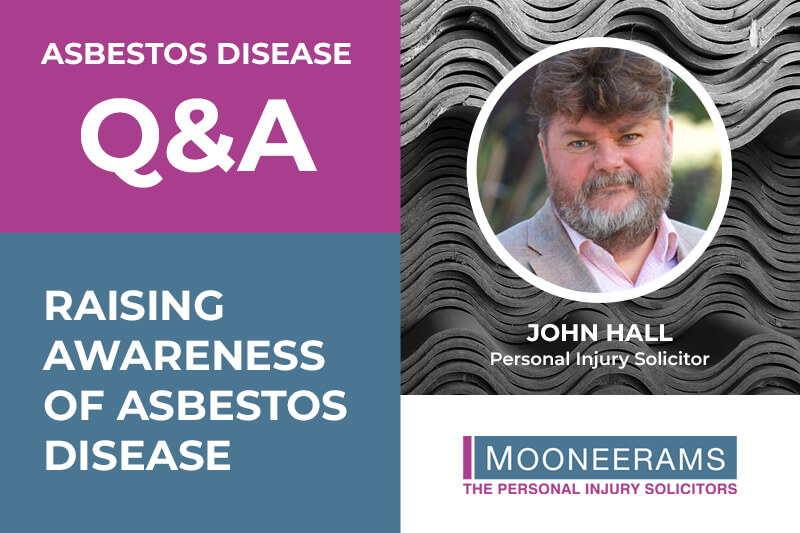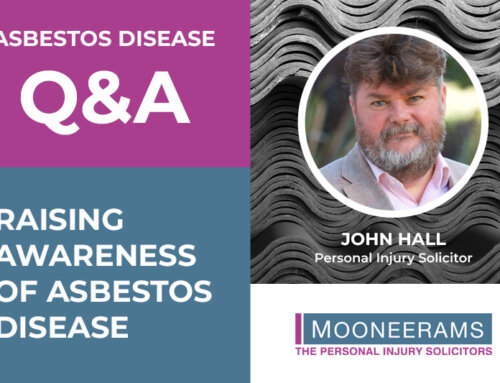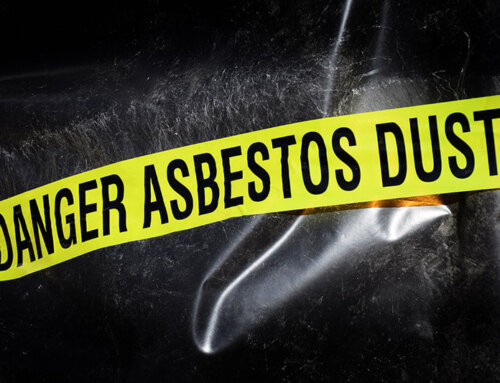This is the fifth blog in a series of seven which was written after we held a Q&A with John Hall, the asbestos solicitor who handles asbestos compensation claims on behalf of Mooneerams. John is acknowledged by the Legal 500 as an expert in his field.
If the previous four blogs, John looked at the various types of asbestos disease. In this blog, he answers a variety of questions that our clients want to know the answers to.
Why are people still being diagnosed with asbestos disease when asbestos was banned so long ago?
By 1970 people knew asbestos had been used and at that point it was clear to all employers that they must not use asbestos products.
However, that didn’t stop many of them from continuing to do so. For example, there were some companies that had stocks of asbestos cement boards that they continued to use into the 1980’s. Others still employed asbestos laggers to make wet mix asbestos using asbestos powder. So, the first thing to say is that although the law was quite clear in the 1970s, it was slow in being implemented until the 1980’s.
The fundamental point is that asbestos had been used in many different ways and quite extensively from before the 1930’s and then onwards. As a result, we got to the 1970s and there would be old lagging around boilers, and pipes, in lofts and roof voids , around calorifiers in factories or even in car clutches and brakes.

Typically, now, if you come across asbestos whilst working, the employer is first of all expected to do an asbestos survey. If any asbestos is found in the working area it must be removed by specialist asbestos removers and disposed of safely.
If, by chance, workers come across any asbestos which has not been picked up in any asbestos survey, then their employers are expected to stop the job and report any exposure to the relevant authorities.
There is of course a problem for sole traders such as electricians, carpenters, or builders etc. in terms of what they should do if they come across asbestos whilst on a job.
In some instances, would they even know if they encountered old asbestos whilst working? Perhaps not, but there is a wealth of information available on the HSE website about what to do if you come across any asbestos and you are working on your own. Amongst other things the website gives information about what asbestos looks like and what you would need to do in the event you came across some.
Generally, these days I would have expected there to be very little asbestos found. That said, I do still take calls from people who say they live in social housing, and someone has been in to change a boiler only to find asbestos nearby.
Are people in social housing at risk of getting asbestos disease if there is any asbestos in the building?
You would need to be exposed to a significant amount of asbestos to get asbestos disease and it would take at least 10 years for the condition to develop.
Remember, the reason I am still seeing clients in relatively large numbers is because whilst they were not meant to have been exposed to asbestos from 1970 onwards, they still were, either because employers were using the stuff, or workers were removing old asbestos.
The disease has a latency period of anything between 10 and 50 years before people may develop the problems we have discussed earlier. It takes at least 10 years for the diagnosis of any of these conditions due to the exposure in the past. Things are now a lot better in terms of the enforcement of asbestos bans that are in place and the availability of information about what to do if you come across it. However, by comparison, things were quite different in the periods when my clients were working with asbestos.
When the final acts of parliament banning asbestos came into force in 1985 and 1999, did that totally stop the use of and exposure to asbestos?
Well, not necessarily, I still have clients that were exposed relatively recently, because some very poor employment practices still occur. They are less common than they used to be, but they still happen.
For instance, I had a case last year where my client was told by his employer to knock out a garage with a lump hammer and bury the asbestos under the building, they were putting on top of the where the garage had been. Shocking behaviour but it still happens.
John, you have said that it generally takes a fairly large amount of asbestos exposure to cause asbestos disease. However, we sometimes read in the Press of cases where people in their early twenties have got asbestos disease. How does this tie in with the notion that someone has to have been exposed to a large amount of asbestos before getting the disease?
This is exactly why these types of cases are dealt with by specialist lawyers. For instance, I have a massive amount of experience in finding out how people were exposed to asbestos, but the skill is not so much knowing everything but being able to apply the knowledge to each individual case I am asked to deal with. Even now, I still come across different ways in which asbestos was used and how people were exposed to it.
The skill is understanding what someone is doing in their work;
- how might they be exposed,
- going through the details of every single job they had, right from the beginning of their working history to the end,
- looking at all the buildings they worked in or on,
- the work processes,
- what equipment they were using,
- whether they worked alongside people working with asbestos,
- whether the buildings themselves were contaminated,
- whether building works were being done i.e., roofs being taken off or equipment being moved around,
- whether they were involved in taking out asbestos partition walls,
- whether they worked in a mill where asbestos material was being sawn up,
- if they worked with asbestos sheets.
Whatever it might be, it is getting to the crux, being quite forensic in your approach and building the overall picture because you need to get evidence your client was exposed to a significant dose of asbestos (and by that we mean enough to cause the disease).
Building the picture will help determine where the exposure occurred. Occasionally I get a case, where the client is diagnosed at a relatively young age, but no one knows where the exposure took place. It is very difficult to run cases like these because you need to prove that there was a history of exposure and that there has been a breach of the law.
There can be cases where there was environmental exposure. For instance, someone living next to an asbestos mill or factories that used asbestos products on a large scale, were at risk of exposure to asbestos dust escaping from those buildings. Large numbers of people were affected by living close in the vicinity of such locations. There were many locations like this, particularly in the North West of England, around the Rochdale area.
The job of an asbestos disease solicitor is to try and find out where the exposure took place.
If you are thinking of making an asbestos claim from your former employer, even if you were exposed to asbestos many years ago, call Mooneerams on 029 2048 3615 or email us at enquiries@mooneerams.com and we’ll get John Hall to call you back.
Read more in our Asbestos Disease Q&A series:




